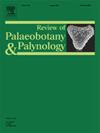蜜蜂讲述了消失的景观的故事:Ürünlü/Kite (Bursa,土耳其)的养蜂场的案例
IF 1.7
3区 地球科学
Q2 PALEONTOLOGY
引用次数: 0
摘要
本研究涵盖了对200年前遗弃的蜂箱的民族考古研究,评估了所研究的蜂房和孢粉学研究的历史意义,并通过孢粉学分析与当代数据进行了比较,解决了花卉多样性的变化。该研究在土耳其Ürünlü (Kite)村进行,探讨了近几个世纪以来养蜂、蜂蜜生产、城市化和农业扩张对古代比提尼亚植物群的影响。大规模的建设、新建筑和景观变化导致了这些传统养蜂场的过时。原始砖房结构的废弃标志着向现代养蜂的转变。蜂蜜学分析表明,蜜蜂不仅是蜂蜜的生产者,而且是植物区系变化的记录者。它们的觅食模式反映了人类引起的植物区系组成随时间的变化。这种独特的养蜂方式的痕迹在土耳其一直存在,特别是在马尔马拉海以南的布尔萨(古代普鲁萨)附近的一个村庄,并有助于其沿丝绸之路的战略位置。周围的村庄,包括Ürünlü,仍然保留着历史上农业和畜牧活动的遗迹。通过多学科方法检查这些废弃的蜂箱,本研究揭示了传统养蜂实践与环境转变之间的相互作用。它强调了历史上的养蜂场对了解过去和现在的植物多样性的重要性,为了解该地区的生态和文化历史提供了宝贵的见解。本文章由计算机程序翻译,如有差异,请以英文原文为准。
The bees tell the story of disappeared landscapes: The case of the apiaries of Ürünlü/Kite (Bursa, Turkey)
This study covers the ethnoarchaeological research on the hives abandoned 200 years ago, which evaluates the historical significance of studied apiaries and melissopalynological research, which addresses the change of floral diversity through palynological analysis in comparison with contemporary data. Conducted in the village of Ürünlü (Kite), Turkey, the study explores the effects of beekeeping, honey production, urbanization, and agricultural expansion on the flora of ancient Bithynia in recent centuries.
Extensive construction, new buildings, and landscape changes contributed to the obsolescence of these traditional apiaries. The abandonment of crude brick hive structures marked the shift to modern beekeeping. Melissopalynological analyses reveal that honey bees serve not only as honey producers but also as recorders of floristic change. Their foraging patterns reflect human-induced changes in floristic composition over time.
Traces of this unique apicultural practice persist in Turkey, particularly in a village near Bursa (ancient Prusa), south of the Sea of Marmara and were contributed to its strategic location along the Silk Road. Surrounding villages, including Ürünlü, still retain remnants of historical agricultural and pastoral activities. By examining these abandoned hives by a multidisciplinary approach, this study sheds light on the interplay between traditional beekeeping practices and environmental transformations. It underscores the importance of historical apiaries in understanding both past and present floristic diversity, offering valuable insights into the ecological and cultural history of the region.
求助全文
通过发布文献求助,成功后即可免费获取论文全文。
去求助
来源期刊
CiteScore
3.50
自引率
21.10%
发文量
149
审稿时长
6 months
期刊介绍:
The Review of Palaeobotany and Palynology is an international journal for articles in all fields of palaeobotany and palynology dealing with all groups, ranging from marine palynomorphs to higher land plants. Original contributions and comprehensive review papers should appeal to an international audience. Typical topics include but are not restricted to systematics, evolution, palaeobiology, palaeoecology, biostratigraphy, biochronology, palaeoclimatology, paleogeography, taphonomy, palaeoenvironmental reconstructions, vegetation history, and practical applications of palaeobotany and palynology, e.g. in coal and petroleum geology and archaeology. The journal especially encourages the publication of articles in which palaeobotany and palynology are applied for solving fundamental geological and biological problems as well as innovative and interdisciplinary approaches.

 求助内容:
求助内容: 应助结果提醒方式:
应助结果提醒方式:


